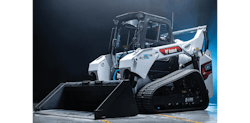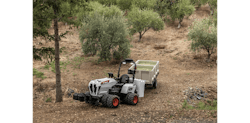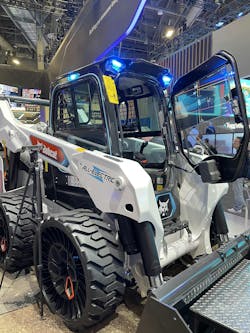Bobcat Aims to Make a Big Leap in Construction Equipment Design
Construction equipment manufacturer Bobcat Co. has made electrification and automation key tenants of its innovation roadmap because of the benefits it sees for the implementation of these technologies.
In recent years it has introduced concept machines demonstrating the company’s technological developments in these areas. Most notably are the S7X all-electric skid steer loader and T7X all-electric compact track loader – both of which utilize electric actuation in place of hydraulics for all motion.
With these and other concepts in development, Bobcat is aiming to bring completely new machines to market which help to improve productivity, safety and more on construction sites.
Power & Motion spoke with Joel Honeyman, Vice President of Global Innovation at Bobcat Co., to learn more about how electrification and automation will contribute to the company’s future development efforts and what role he sees hydraulics continuing to play in the construction equipment industry.
*Editor’s Note: Questions and responses edited for clarity.
Power & Motion (P&M): Over the last couple of years Bobcat has introduced some electric and autonomous machine concepts – how do these fit in with the company’s overall innovation roadmap and what is driving the company to invest in these technologies?
Joel Honeyman (JH): If I go back to the beginning, Bobcat, the originator of the skid steer loader industry, and we did this more than 65 years ago – I think when we look at what we've done, we also realize there's a lot of new technologies coming that will enable us to do more things in the future. And it's all about making our customers more productive. When we look at electrification and autonomy, those are two really big pieces that we see that can help automate certain tasks or make them more comfortable or do different things with those technologies.
So, we embarked on this journey to build believable pilot machines a number of years ago and to take them out with customers. And that's what we did. We found a number of customers really, really liked these different technologies and the applications of them. Our interest began before that, but we validated it then when we took these concepts out, and really started getting some momentum, and again, learn how people will use them.
READ MORE: Construction Equipment Digs Deeper into Electrification
P&M: What have been the biggest technological advancements which have enabled these machines to come to fruition?
JH: On the electrification side, it was this whole concept of being all electric. The T7X, which is the world's first all-electric compact track loader, not only did we take the engine package and remove it and put a battery in, we got rid of all the hydraulics on the machine. We use electric actuation to do all the motion. That was a theory; our team built this prototype in about 6 weeks and they had this theory to say, ‘hey, if we did electric actuation, could we do some different things? And would it actually perform?’ And sure enough, in 6 weeks, they built this first prototype. We drove it around, and we said, wow, there's really some interesting things we can do with it.
When you go all electric, it allows you to do so many different things. We know the position of the cylinder and the work group; we know the current draw and the current that we need because it's electric. And because of all those things that we can do programmatically through software, we can provide different features, things you can't do with maybe a hydraulic machine. Then coupling that with electric, it's just really, really quiet. You eliminate a lot of noise and vibration and other things for the operator and for bystanders on the job site. You start coupling all those things together and it's just a totally different experience for people. On the electric side, that was really important for us.
Our approach for autonomy is maybe a little bit more of a step by step [process]. There are companies out there that are trying to solve all of autonomy. I don't know if that's necessarily the right path. We're more about what are the things we can do even while an operator is in the cab of the machine. So, we've started to work [on developing] that. And then how can we combine these technologies. Four or 5 years ago we launched Max control, which was a simple iPhone remote control that you can plug into one of our loaders. And that was a basic step.
Now, this year we're launching a collision warning and avoidance system using radar technology. So even when the operator is in the machine if they backup, the machine will stop or derate if it encounters an object. But of course, we need that for autonomy. So, when you start combining these technologies together, now a machine can maybe move on a site from point A to point B, move materials, whatever it might be. And so that is really what our progression is. Again, we take these out to customers, and they tell us, ‘Hey, we really like these solutions because if it can eliminate just a cut, or advance a couple of simple tasks, we're in.’ And so that's where we’ve started on that part of the journey. But again, those two technologies really drove a lot of the work we've been doing over the last couple of years.
P&M: How, if at all, do any of these technology development initiatives fit in with trends the company is seeing in the compact equipment industry, and/or overall heavy equipment industry?
JH: Well, I would say they don't fit because there is no one else out there that's putting these concepts out that I'm aware of. I can only speak for our company. All electric, we're well far out there [with] that kind of technology and commercializing that. And as far as I know, we'll be the first ones using this active radar for this collision warning and avoidance system coming up this year.
Now, others are working on it, we know this, and there are some electric converted vehicles and some other things out there. But I think if you're going to truly be innovative and rethink what you do in the future, you’ve got to put some forward-thinking things out there. Now, here's what I'm always quick to point out to people – we still are making diesel-hydraulic machines, we're still going to do that for a very long time. The however statement is I get calls and emails from select customers who say, ‘I really want that solution,’ they want an all-electric loader for a particular application or for something they're working on, or they want autonomy for a particular application. We’ve been getting numerous emails and calls on autonomy here within the last several months. And so again, it's for those people in those applications. Maybe not for everybody, that's okay, we offer both.
We're really proud of the work that we've done here as an organization, as a company, to really bring these things and make them believable. It's one thing for me to put a PowerPoint out there and describe it but is it believable. Then people drive it. This is what I tell people, especially on electric [machines], because we read the blogs, there's some skepticism out there. But I tell them just try it and then tell me what you think. We've had some very skeptical customers driving electric equipment. We interviewed before, and they told us their skepticism; afterwards they're like ‘Man, I, I would buy one of these’ for the power, the performance, the quietness and all the other things. It's new technology, you’ve got to try it.
READ MORE: The Impacts of Electrification on Fluid Power Systems
P&M: Are customers at a point now where they want to invest in electrification, automation and other advanced technologies? What are some challenges or things that are holding people back from investing in them yet?
JH: I think there is a willingness for customers to try it. I know there's skeptics out there. But again, they are willing to try…we brought those skeptics into our facility in Bismarck; they were curious. And then once they tried it…so I think once we start to commercialize these solutions, they come available in the marketplace, somebody sees it on a job site, they see one of their buddies has it at another company. Hey, can I try that? I see I see this Bobcat machine has this and this on it, can I try that out? How does it work? That's technology adoption, right? It's word of mouth. That's the best advertising for it.
I think we're going to see a lot more of that. And then it's the volume, it’s just the volume of being able to produce enough for these vehicles, get them out in the marketplace, us and other manufacturers who have some different technologies they're experimenting with. It's just getting them [the machines] on the sites and trying them out. That's why for our first electric machines, we're working with Sunbelt Rentals to be our rental partner, because by renting you get to lots of different customers [who get] the opportunity to experience it. We feel like rental could be a really good way for people to try out this new technology along the way and maybe dispel some of the skepticism that's out there. It's okay. There are people that didn't like iPhones when they first came out and they're using them now. And that's okay. You know what, challenge accepted. We like to say challenge accepted because if it doesn't work or fit, you're right, we shouldn't produce it. And we're good as an organization saying that, but let's not criticize until we try it.
P&M: For the T7X and S7X electric machines introduced in the last 2 years, Bobcat worked has integrated full-electric systems which eliminate the use of hydraulics – so what sort of future does Bobcat possibly see for hydraulics in mobile equipment applications? Will there still be use cases for these systems? And what benefits does the company possibly see to moving to full-electric systems utilizing electric actuators and other technologies in place of hydraulics?
JH: I think it's both yet. Our roots are in hydraulics; we’ve got a lot of hydraulics engineers, I'm a mechanical engineer by education, so we understand fluid power and motion really well. The however is, in some applications using electric actuation, in whatever form or fashion, just provides some different efficiencies, maybe some different information as I pointed out [previously]. We can know the position of the cylinder, we can know the current, and those are really important.
As an example, the tilt on the front of our electric loaders, we know when there's a current spike with that electric actuator. When we hit that spike, we can back off that motion and prevent damage to the machine. We can't do that with a hydraulic [system]. Those are the types of things that I think we're going to see. Even with the all-electric platform, I think it's really opened up the eyes of not just us internally, but across the industry, around how can we use electric types of motion rather than hydraulics in some certain places that just makes sense, where maybe you don't need that and the complications of running hydraulic lines and a block and all those other things, and oil. Are there some things you can do with electric? I think you're going to start to see that.
Clearly a lot of our suppliers, which I know are suppliers for some of our competitors, are asking us questions or working on it. So, I think you're going to start to see more of that; you're going to start to see more of that in agriculture, also because it just makes sense to potentially remove some of those [hydraulic] items. I think you're going to slowly see it along with us having some all-electric products, which just allow us to do so many different things. Another feature, you can hit a button on a joystick and you get an automatic bucket shakeout, you can violently shake the bucket to remove material. Again, you can't do that as easily on a hydraulic machine. So again, finding those places where you can just add some value along the way. It's going to be both, but I think we are going to start to see more electrified types of components come into linear motion and actuation on these vehicles.
P&M: Do you see the combination or marrying of the two working together in machines as well?
JH: I think it’s all possible. I think it’s just a matter of how efficient you want to make a particular operation on the machine and what are those combinations of [technologies]. There are hybrids out there, people that are running a small engine with a battery pack. And then being able to electrify certain portions of the drive, let's say, because it just made it more efficient, they had more control or even more torque if going direct drive. I do think there is going to be a combination of those things that you'll see on different types of equipment.
P&M: Besides electrification and automation, are there are other key technological areas in which Bobcat is focusing for its innovation roadmap?
JH: The other pillar that we talk about is connectivity. And connectivity, not just telematics, we've already commercialized that, but we think of more connectivity to the operator to the machine to the worksite. What we showed at CES was this really cool T OLED screen that was embedded in the front glass of the door of one of our loaders. And it's transparent, so you can still view through it, but information can be on it like a video, there could be a camera view, worksite features. We can also incorporate augmented reality types of features so we could embed, let's say what the utility lines are on the site. And as you drive the site, you can see those in augmented reality in real spatial. These are cool concepts, they're not commercialized…but that's the possibility; and being able to show grade and elevation. One of the things for construction [that] is really important is grade and elevation. And if we can show grade and elevation within that screen or automatically within the vehicle, without a lot of sophisticated equipment, that would be a real win for customers going forward.
P&M: What technological developments and advancements are you most excited to work on and/or see come into the market in the coming years?
JH: I'm the tech guy, so I'm excited about all of them. I think it's just starting to see some of these things on the jobsite, whether it's some electrified product or it's something that has some of the autonomy features, like this collision warning and avoidance system, especially with the radar, I think is really exciting. And then just to see how people experience it. These are all totally new technologies; to me, the thrill is seeing the customer's eyes light up and the smile on their face when they've tried one of these and they go, ‘Wow, I can't believe I just drove that, and that machine did that.’
That is what we're looking for; incremental changes and improvements have been happening for a long time on our equipment and competitor equipment. We want to make the big leap. We want the wow. What’s the wow that really, really inspires a customer to say, ‘yeah, there's something here.’ And again, it may not be perfect at first, that's okay. But if they understand the concept, where we're heading, and they can help us to formulate it further or refine it, we're all good. But I want to see their eyes light up and the smiles on their face when they drive [the equipment].
READ MORE: The 5 Levels of Autonomy in Off-Highway Equipment






